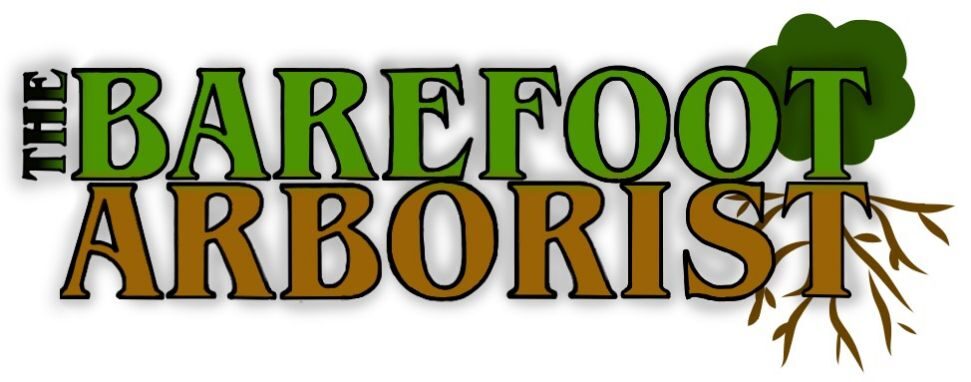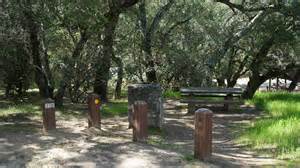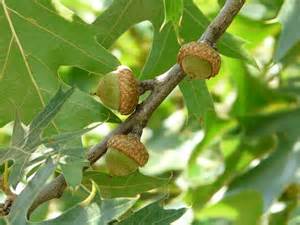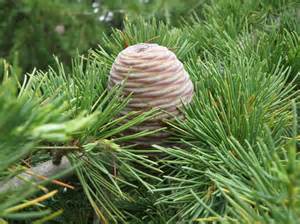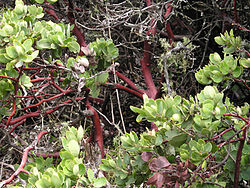Live Oak
Live oak or evergreen oak is a general term for a number of unrelated oaks in several different sections of the genus Quercus that share the characteristic of evergreen foliage.
The name live oak comes from the fact that evergreen oaks remain green and “live” throughout winter, when other oaks are dormant and leafless. The name is used mainly in North America, where evergreen oaks are widespread in warmer areas along the Atlantic coast from southeast Virginia and North Carolina to Florida, west along the Gulf Coast to Louisiana and Texas, and across the southwest to California and southwest Oregon.
Evergreen oak species are also common in parts of southern Europe and Asia, and are included in this list for the sake of completeness. These species, although not having “live” in their common names in their countries of origin, are colloquially called live oaks when cultivated in North America.
When the term live oak is used in a specific rather than general sense, it most commonly refers to the southern live oak (Quercus virginiana), the first species so named, and an icon of the Old South,[2] but can often refer to other species regionally.
Black Oak
California black oak is a deciduous tree growing in mixed evergreen forests, oak woodlands, and Coniferous forests. California black oak is distributed along foothills and lower mountains of California and southern Oregon.
It is found from Lane County, Oregon, south through the Cascade Range, the Sierra Nevada, and the Coast, Transverse, and Peninsular ranges to San Diego County, California and into Baja California. The tree occurs in pure or mixed stands. Pure stands usually indicate sites unfavorable to conifer growth or recurring disturbance such as fire or logging activities. The tree can grow in many types of soils, but it is important that the soil be well-drained.
Quercus kelloggii typically grows from 9–25 m (30–80 ft) in height and from 0.3-1.4 m (1-4.5 ft) in diameter. Large trees may exceed 36 m (120 ft) in height and 1.6 m (5 ft) diameter. The species also grows in shrubby scrub-oak form on poor sites.[1] In open areas the crown is broad and rounded, with lower branches nearly touching the ground or forming a browse line. In closed stands, the crown is narrow and slender in young trees and irregularly broad in old trees. Trunks are usually free of branches on the lower 6–12 m (20–40 ft) in closed stands.[1] Trunks are often forked, and usually decayed and hollow in older trees. The bark is thin and smooth in young trees, becoming thick, ridged, and plate-like with age.[1] This oak grows from one to several vertical roots which penetrate to bedrock, with large, laterally spreading roots extending off from vertical ones. It also has a number of surface roots.
Acorns are relatively large in this species, from 2.5–3 cm (1-1.2 in) long and 1.5-1.8 cm (0.6-0.7 in) wide. The deeply lobed leaves are typically 10–20 cm (4–8 in) long. While individual trees generally have a lifespan between 100 and 200 years, California black oak can live up to 500 years of age.[1]
The tree reproduces when its acorns sprout to form seedlings. It also reproduces vegetatively with new growth sprouting from the root crown after the tree is top-killed by wildfire, logging, frost, or other events.[1]
Incense-Cedar 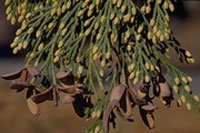
Librocedrus decurrens
Habitat
The native range of this tree includes areas near Mount Hood in Oregon, south to the Siskiyou, Klamath, Cascade, Coast and Sierra Nevada Mountain ranges of California. Incense-cedar grows as far south as the Sierra de San Pedro Martir mountains of Baja California. Incense-cedar tolerates a variety of soil types and can be found from 2,000 – 7,000 feet in elevation in areas with dry summers.
Life History
Incense-cedar is monoecious and bears cones as early as September. Pollen is shed in late winter to early spring. Incense-cedar is fairly shade tolerant and is often found growing in the shade of taller trees such as ponderosa pine and Douglas-fir.
Distinctive Characteristics
- Graceful, drooping branches
- Trunks with fibrous, cinnamon colored bark
- Needles are scale-like and flattened as if they have been ironed
- Cones are up to 4 cm long when they mature in the summer and resemble an open duck’s bill when the two longest scales open
Importance
Incense-cedars provide habitat for mountain chickadees which nest in the trees and eat insects living in the tree bark. Tannins in the tree give the wood resistance to decay and repels moths, making incense-cedar ideal for decking, outdoor furniture, siding, railway ties, and closets. Have you used a pencil today? Most pencils are made of incense-cedar. Sharpen your pencil to smell the aromatic fragrance of incense-cedar wood.
Deodar Cedar
Scientific Name: Cedrus deodara
Other Common Names: Himalayan cedar
Summary
Foliage: Needled Evergreen
Height: 40-70 feet
Spread: 20-45 feet
Shape: Pyramidal
Growth Characteristics: Fast-growing (fastest of all cedars)
Native to the Himalayas, the Deodar Cedar is a graceful, dense, and soft-textured pyramidal tree with slightly pendulous, tiered branches. The leader tends to be somewhat bowed. The needles are the longest of any cedar, measuring from 1.5-2 inches in length. As the tree ages, lower branches tend to bend towards the ground, and the silhouette can be quite striking.
Manzanita
Manzanita is a common name for many species of the genus Arctostaphylos. They are evergreen shrubs or small trees present in the chaparral biome of western North America, where they occur from southern British Columbia and Washington to California, Arizona and New Mexico in the United States, and throughout Mexico. They are characterized by smooth, orange or red bark and stiff, twisting branches. There are 106 species of manzanita, 95 of which are found in the Mediterranean climate and colder mountainous regions of California, ranging from ground-hugging coastal and mountain species to small trees up to 20 feet (6m) tall. Manzanitas bloom in the winter to early spring and carry berries in spring and summer.[1] The berries and flowers of most species are edible.
The word manzanita is the Spanish diminutive of manzana (apple). A literal translation would be little apple. The name manzanita is also sometimes used to refer to species in the related genus Arbutus, which is known by that name in the Canadian area of the tree’s range, but is more usually known as madroño, or madrone in the United States.
Jeffrey Pine 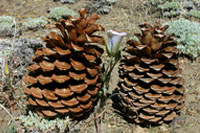
Pinus jeffreyi
Habitat
Jeffrey pine can be found at elevations ranging from 5,000 to 9,000 feet. It grows in southwestern Oregon, south to the Sierra Nevada Mountains of California, western Nevada and as far south as Baja California. Jeffrey pine thrives in harsh environments.
Life History
Jeffrey pine is a monoecious species. Cones mature in the summer of the second season and shed their seeds in late summer. Trees as young as 8 years may produce seeds. Jeffrey pine is intolerant of shade and requires an open space with little competing brush and grass vegetation in order to become established.
Distinctive Characteristics
- Large beehive shaped cones 13 to 24 cm long, spines point inward and do not poke hands when picked up
- Needles are arranged three to a bundle, grayish to blue-green in color, up to 24 cm in length
- Bark smells like vanilla or pineapple
Importance
Seeds are popular with many birds and black bears eat the seeds off the forest floor. Squirrels, chipmunks and mice store seeds in holes that they dig in the ground. Uneaten seeds sprout up as new seedlings.
The wood from Jeffrey pines is used in door and window frames, wood paneling and furniture.
Fun Fact
The chemical component of Jeffrey pine sap contains the hydrocarbon – normal heptane, which is highly explosive.
Ponderosa Pine 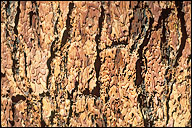
Pinus ponderosa
Habitat
Ponderosa pine is likely the most common conifer in California. In the west, ponderosa pine is distributed from southern Canada into Mexico and can be found at elevations from 2,000 feet to 5,000 feet Ponderosa pine is a fire adapted species; older trees have thick bark that protects the tree from low intensity fire.
Life History
Ponderosa pine is a monoecious species. Seedlings regenerate most successfully after disturbance that removes competing vegetation and exposes bare soil. Ponderosa pine is shade intolerant.
Distinctive Characteristics
- Tufts of long (10 inches), shiny, bright green needles, 3 needles to a bundle
- Bark has a puzzle-like pattern is brownish red and furrowed
- Cones are three to five inches long and have spines which point outward, making them prickly.
Importance
Ponderosa pines provide seeds that are an important source of food for many wildlife species. Larger animals like deer and bears use the forests for cover and shelter. These beautiful forestlands are also popular recreational destinations for many Californians. In addition, ponderosa pine is a valuable timber species for used for flooring, paneling, window and door sills and a variety of other building products.
White Fir 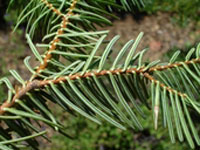
Abies concolor
Habitat
White fir has a wide distribution from central Oregon to the coastal mountains of California, south into the Sierra Nevada and the northern most mountains of Mexico. It also grows in the Rocky Mountains. In California, it grows best on the western slopes of the Sierra Nevada and in the southern Cascades.
Life History
White fir is monoecious and female cones develop on the upper part of the tree. Cones sit upright on branches, are 3 to 5 inches long and disintegrate on the tree. Seedlings germinate after snowmelt and are shade tolerant with the ability to survive beneath brush cover until they eventually grow tall enough to overtop the brush.
Distinctive Characteristics
- Needles have a frosted appearance from below and are flat and aromatic when crushed. Needles are twisted at the base.
- Bark on young trees is thin and grayish with resin blisters
- Older trees have deeply furrowed bark that has a mottled, bacon-like appearance when peeled from the tree.
Importance
Whit fir provides cover and food for forest animals. It is a popular species grown on Christmas tree farms and also is a construction-grade wood used for plywood and framing.
Sugar Pine 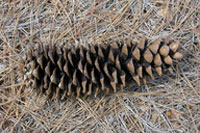
Pinus lambertiana
Habitat
In California, sugar pine can be found in the Klamath, Siskiyou and North Coast Ranges, as well as the Sierra Nevada and as far south as the Sierra San Pedro Martir in Baja California. It grows in a wide variety of climates and soil types and its elevation ranges from near sea level in the North Coast forests to nearly 10,000 feet in Baja California.
Life History
Sugar pine is the tallest and largest of the pines. It’s cones may be as long as 24 inches and are the longest cones of any pines. Trees are monoecious and cones develop over two years. Sugar pine is more tolerant of shade than ponderosa pine, but less shade tolerant than Douglas-fir. Distinctive Characteristics
- 5 needles to a bundle, needles approximately 4 inches long
- In summer, pendulous cones hang from ends of branches like Christmas tree ornaments.
- Cones are usually over one foot long
Importance
Sugar pine sap was used by Native Americans as a laxative. Trees produce food and habitat for a number of birds and small mammals. Sugar pine’s high quality wood makes it ideal for use in molding, frames for windows and doors, paneling and piano keys.
Douglas-fir 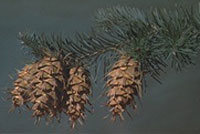
Pseudotsuga menziesii
Habitat
The native range of this conifer includes areas of British Columbia, through western Washington, Oregon, the Coast and Klamath Ranges of California and into the mixed conifer forest of the Sierra Nevada. These habitats range from wet in the Pacific Northwest, to dry in the mountains of the Sierra Nevada. It can be found at sea level to nearly 7,500 feet.
Life History
Douglas-fir is monoecious, which means that the tree has both male and female cones on the same tree. The tree usually begins to produce cones when the tree reaches 12-15 years of age. The tree is considered to be intermediate in shade tolerance and does well as a pioneer species in areas that have been cleared of competing vegetation.
Distinctive Characteristics
- Female cones are approximately 5-9 cm long and range from deep green when young to reddish-brown as they age.
- Scales on the cones are papery and have 3 pronged bracts that stick out between each bract. (Resembling mouse hind legs and tail)
- Needles are flat and are spirally arranged around the twig. (Resembling a bottle brush)
- Graceful, drooping limbs
- Gray, scaly bark, deep furrows
Importance
Trees provide habitat and seeds provide a food source for birds and other small animals such as mice and chipmunks. Characteristics of Douglas-fir wood give it a superior strength to weight ratio, making it a first choice for structural lumber. Douglas-fir lumber was probably used to build the frame of your home.
